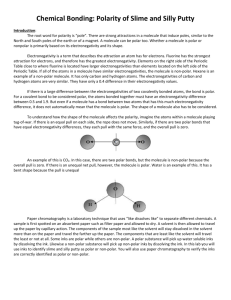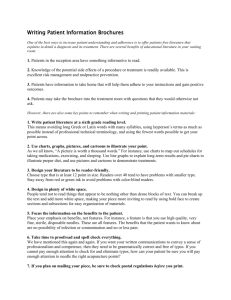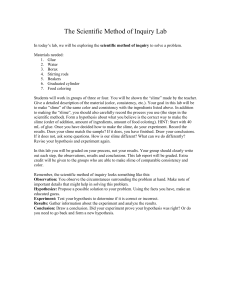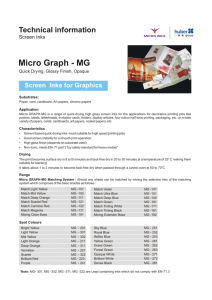Chemical Bonding: The Polarity of Slime and Silly Putty Introduction
advertisement
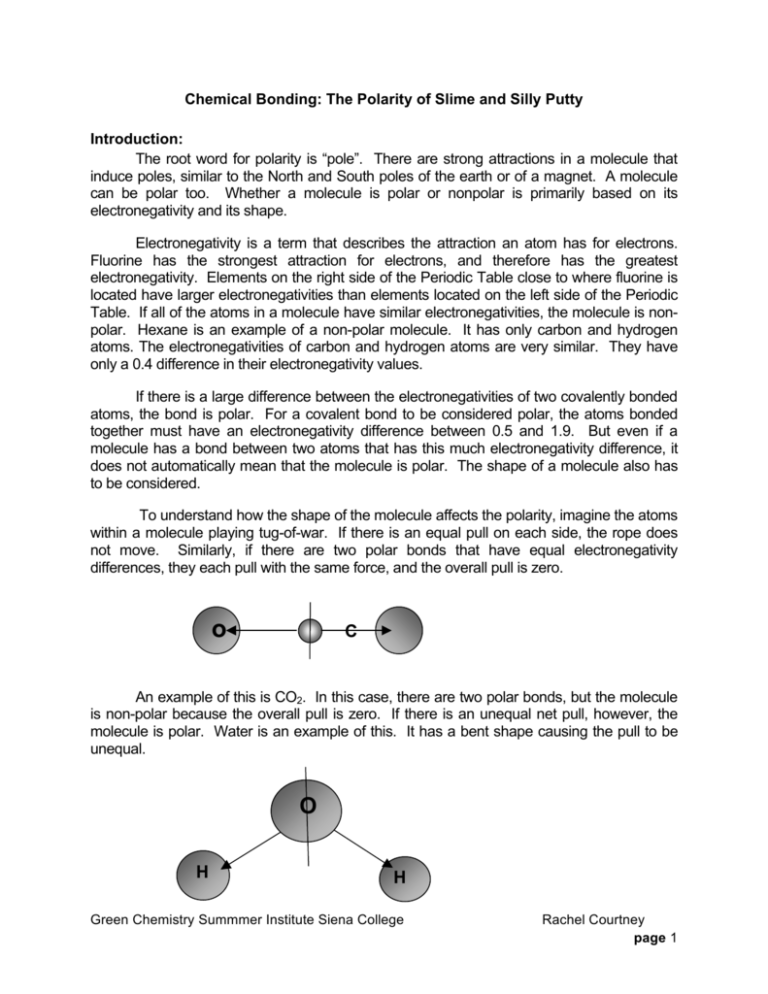
Chemical Bonding: The Polarity of Slime and Silly Putty Introduction: The root word for polarity is “pole”. There are strong attractions in a molecule that induce poles, similar to the North and South poles of the earth or of a magnet. A molecule can be polar too. Whether a molecule is polar or nonpolar is primarily based on its electronegativity and its shape. Electronegativity is a term that describes the attraction an atom has for electrons. Fluorine has the strongest attraction for electrons, and therefore has the greatest electronegativity. Elements on the right side of the Periodic Table close to where fluorine is located have larger electronegativities than elements located on the left side of the Periodic Table. If all of the atoms in a molecule have similar electronegativities, the molecule is nonpolar. Hexane is an example of a non-polar molecule. It has only carbon and hydrogen atoms. The electronegativities of carbon and hydrogen atoms are very similar. They have only a 0.4 difference in their electronegativity values. If there is a large difference between the electronegativities of two covalently bonded atoms, the bond is polar. For a covalent bond to be considered polar, the atoms bonded together must have an electronegativity difference between 0.5 and 1.9. But even if a molecule has a bond between two atoms that has this much electronegativity difference, it does not automatically mean that the molecule is polar. The shape of a molecule also has to be considered. To understand how the shape of the molecule affects the polarity, imagine the atoms within a molecule playing tug-of-war. If there is an equal pull on each side, the rope does not move. Similarly, if there are two polar bonds that have equal electronegativity differences, they each pull with the same force, and the overall pull is zero. o o C An example of this is CO2. In this case, there are two polar bonds, but the molecule is non-polar because the overall pull is zero. If there is an unequal net pull, however, the molecule is polar. Water is an example of this. It has a bent shape causing the pull to be unequal. O H H Green Chemistry Summmer Institute Siena College Rachel Courtney page 1 Polar molecules such as water, vinegar, or ethanol dissolve other polar molecules. Non-polar molecules, such as oil or gasoline, dissolve other non-polar molecules. This trend is known as “like dissolves like.” Since sugar dissolves in water, is sugar polar or nonpolar? If you said polar, you are correct. Sugar is a polar molecule since it is dissolved water, a polar molecule. Paper chromatography is a laboratory technique that uses “like dissolves like” to separate different chemicals. A sample is first spotted on an absorbent paper such as filter paper and allowed to dry. A solvent is then allowed to travel up the paper by capillary action. The components of the sample most like the solvent will stay dissolved in the solvent more than on the paper and travel the farther up the paper. The components that are least like the solvent will travel the least or not at all. Some inks are polar while others are non-polar. A polar substance will pick up water soluble inks by dissolving the ink. Likewise a non-polar substance will pick up non-polar inks by dissolving the ink. In this lab you will use inks to identify slime and silly putty as polar or non-polar. You will also use paper chromatography to verify the inks are correctly identified as polar or non-polar. Learning Objectives: 1. Compare and contrast the chemical bonding properties of slime and silly putty. 2. Demonstrate knowledge gained about polar and non-polar bonding through supporting or rejecting his/her hypothesis about which inks will be absorbed. 3. Learn about the technique of chromatography and how it is often used to separate the components of a mixture based on their polarity. Materials: • Borax Solution (4%) • White Glue • Distilled Water • 50 mL and 100 mL (or 250 mL) graduated cylinder • 250 mL beaker • 500 mL beaker • Silly Putty • Notebook Paper • Newspaper Green Chemistry Summmer Institute Siena College • • • • • • Variety of Inks: Uni-Ball Pens, Sharpies, Highlighter, and Dry Erase Markers 250 mL Beaker Filter Paper Stirring Rod Spatula Zip Lock Plastics Baggies (for storing slime) Rachel Courtney page 2 Hazard Information: Chemical Name Health Hazards Physical Hazards Environmental Hazards Borax Slight skin and eye irritant Severe exposure/rapid absorption may cause reproductive effect None Products of degradation are non-toxic Slight fire hazard None White Glue None Waste: Description of Material (include concentration) Quantity per student Hazard Disposal Method Slime About 5 grams None Trash Procedure: Part 1. Making Slime 1. If slime is provided go to Part 2. If not, weigh out 4.0 grams (1 teaspoon) of borax into a 250 mL beaker. 2. Measure out 235 mL of distilled water and pour into the 250 mL beaker that contains the borax. 3. Stir the mixture for at least 3 minutes or until the borax has dissolved. 4. Measure out 115 mL of distilled water and 115 mL of white glue (about ½ cup) and pour into a 500 mL beaker. Stir the mixture. 5. Pour the borax solution from the 250 mL beaker into the diluted glue mixture in the 500 mL beaker and stir the solution until it becomes slime. 6. Record observations about the slime. 7. Wash your hands before moving on to the next part! Part 2. Slime and Silly Putty Ink Tests Green Chemistry Summmer Institute Siena College Rachel Courtney page 3 1. On a piece of notebook paper make one 20-25 mm long mark of each of the inks you are testing. Space the marks at least one inch apart. Use a pencil to label each mark with its description. o Water soluble inks include a highlighter and a Uni-ball pen. o Water insoluble inks include a Sharpie pen/marker, newsprint, and a dryerase marker. 2. While the inks are drying, select a passage or a picture in the newspaper to test with the slime. 3. Break off a small piece that is 3-5 cm in diameter of slime. Gently place this piece on top of the newspaper ink, and then carefully pick it up again. 4. Observe and record whether or not the ink was picked up onto the slime. 5. Break off another small piece of slime. Gently place it on top of the first dried ink on the notebook paper, and then carefully pick it up. Repeat this for each of the inks. 6. Observe and record which inks were picked up (dissolved) by the slime in Table 1. Repeat this ink testing two more times for accuracy. 7. Store the slime in zip lock plastic bag. 8. Before performing ink tests on silly putty, in the data section hypothesize which inks the silly putty will pick up. 9. Perform ink tests on silly putty in the same manner as above. 10. Record results in Table 2. Part 3. Chromatography of Ink Samples 1. Use a pencil or scissors to poke a small hole in the center of a piece of filter paper (see Figure 1). 2. Spot the filter paper evenly spaced ~3 cm from the small hole with the two insoluble inks and the two soluble inks that were used in Part 2. 3. Obtain a ½ piece of filter paper. Fold the paper in half several times so that it makes a narrow wick. 4. Insert the wick into the hole of the spotted paper so that it is above the top of the filter paper by ~2 cm. 5. Fill a 250 mL beaker 3/4 full with distilled water. Green Chemistry Summmer Institute Siena College Rachel Courtney page 4 6. Set the filter paper on top of the beaker so that the bottom of the wick is in the water. The paper should hang over the edge of the beaker with the spotted side up. 7. Allow water to travel until it is ~1 cm from the edge of the filter paper. Remove the filter paper from the beaker. 8. Observe which inks moved from where they were originally spotted. Record your observations in Part 3 of Data. Figure 1: Chromatography Apparatus Green Chemistry Summmer Institute Siena College Rachel Courtney page 5 Data: Part 1. Observations for Slime (if slime is made): Part 2. Table 1. Results of Ink Testing for Slime Picked up (dissolved) Did not pick up (dissolve) Name of Ink Test 1 Test 2 Test 3 Test 1 Test 2 Test 3 Newsprint Highlighter Uni-ball pen Sharpie marker Dry-erase marker v Hypothesis of which inks silly putty will pick up: Green Chemistry Summmer Institute Siena College Rachel Courtney page 6 Table 2. Results of Ink Testing for Silly Putty Picked up (dissolved) Did not pick up (dissolve) Name of Ink Test 1 Test 2 Test 3 Test 1 Test 2 Test 3 Newsprint Highlighter Uni-ball pen Sharpie marker Dry-erase marker Part 3. • Observations of inks following chromatography: Green Chemistry Summmer Institute Siena College Rachel Courtney page 7 Post Lab Questions 1. Did the slime pick up water soluble or water insoluble inks? From these results what can use conclude about the polarity of slime? ______________________________________________________________________ ______________________________________________________________________ ______________________________________________________________________ 2. Explain how you determined your hypothesis about whether or not silly putty would pick up water. Was your hypothesis correct? ______________________________________________________________________ ______________________________________________________________________ ______________________________________________________________________ 3. Were the inks you used properly classified as soluble and insoluble? Explain your answer. ______________________________________________________________________ ______________________________________________________________________ ______________________________________________________________________ References: Henrie, Sally. “Chemical Bonding: The Polarity of Slime and Silly Putty.” Green Chemistry Lab Manual. Union University, 2002. Green Chemistry Summmer Institute Siena College Rachel Courtney page 8 TEACHER INFORMATION Regents Core • Standard 4: o Key Idea 3 § 3.1nn § 3.1 oo o Key Idea 5 § 5.2 k Teacher Tips: -The slime works best when it is slightly wet (it dries out easily when the students handle it). Preparation: -Setting up the lab equipment and materials -Preparing a 4% solution of Borax (if you do not want the students to make it when making the slime-this would eliminate steps 1 though 3 from Part 1). Sample Data: Part 2. Table 1. Results of Ink Testing for Slime Picked up (dissolved) Did not pick up (dissolve) Test 1 Test 1 Name of Ink Test 2 Test 3 Newsprint Highlighter X X X Uni-ball pen X X X Sharpie marker Green Chemistry Summmer Institute Siena College Test 2 Test 3 X X X X X X Rachel Courtney page 9 X Dry-erase marker X X Table 2. Results of Ink Testing for Silly Putty Picked up (dissolved) Did not pick up (dissolve) Test 1 Test 2 Test 1 X X Name of Ink Newsprint Test 3 Test 2 Test 3 X Highlighter X X X Uni-ball pen X X X Sharpie marker X X X Dry-erase marker X X X Part 3. • Observations of inks following chromatography: The water-soluble inks traveled on the filter paper and their components were separated. The water insoluble inks did not travel on the filter paper. Answers to Questions Post Lab Questions 1. Did the slime pick up water soluble or water insoluble inks? From these results what can use conclude about the polarity of slime? The slime picked-up or dissolved the Uni-ball pen and highlighter, which are water soluble inks. From this result and the rule “like dissolves like” it can be determine that slime is polar just the water soluble inks are polar. 2. Explain how you determined your hypothesis about whether or not silly putty would pick up water. Was your hypothesis correct? The drawing of my hypothesis resulted from the early test of newsprint. The newsprint test revealed that it was only dissolved by silly putty and not by slime. However, following the test with slime it was found that slime dissolved water soluble inks. This means it was polar. Therefore the silly putty must be the opposite or non-polar. Green Chemistry Summmer Institute Siena College Rachel Courtney page 10 3. Were the inks you used properly classified as soluble and insoluble? Explain your answer. Yes. Water soluble inks spotted on the filter paper should dissolve in the water and travel and separate on the filter paper. Water insoluble inks should not dissolve in the water and travel on the filter paper. The inks classified as water soluble (highlighter and Uni-ball pen) traveled and on the paper and the water insoluble inks (dry-erase marker and Sharpie marker) did not. 1. How has this lab been modified to make it “greener”? This lab uses safer chemicals and produces little to no chemical waste. 2. Which of the 12 principles of Green Chemistry were employed to make this lab greener? Please check all that apply. o o o o o o o o o o o o Prevention It’s better to prevent waste than to treat or clean up waste afterwards. Atom Economy Design synthetic methods to maximize the incorporation of all materials used in the process into the final product. Less Hazardous Chemical Syntheses Design synthetic methods to use and generate substances that minimize toxicity to human health and the environment. Designing Safer Chemicals Design chemical products to affect their desired function while minimizing their toxicity. Safer Solvents and Auxiliaries Minimize the use of auxiliary substances wherever possible make them innocuous when used. Design for Energy Efficiency Minimize the energy requirements of chemical processes and conduct synthetic methods at ambient temperature and pressure if possible. Use of Renewable Feedstocks Use renewable raw material or feedstock rather whenever practicable. Reduce Derivatives Minimize or avoid unnecessary derivatization if possible, which requires additional reagents and generate waste. Catalysis Catalytic reagents are superior to stoichiometric reagents. Design for Degradation Design chemical products so they break down into innocuous products that do not persist in the environment. Real-time Analysis for Pollution Prevention Develop analytical methodologies needed to allow for real-time, in-process monitoring and control prior to the formation of hazardous substances. Inherently Safer Chemistry for Accident Prevention Choose substances and the form of a substance used in a chemical process to minimize the potential for chemical accidents, including releases, explosions, and fires.1 1 Retrieved from http://www.epa.gov/sciencematters/june2011/principles.htm Green Chemistry Summmer Institute Siena College Rachel Courtney page 11 Green Chemistry Summmer Institute Siena College Rachel Courtney page 12

